தொன்மையான நடராஜர்
இராஷ்டிரகூடரின் காலத்தைச் சார்ந்த மும்பையின் புறநகர்ப்பகுதியான கரபுரி என்னும் எலிபெண்டா தீவுகளின் மகோன்னதமான ஆடல்வல்லானைப்பற்றி விவரித்திருந்தது
நச்ன குதாராவிலுள்ள பொ.யு.ஐந்தாம் நூற்றாண்டு ஆடல்வல்லானின் சிற்பம். உடைந்த நிலையில் இருப்பினும் இங்கே டோல ஹஸ்தமாக வலக்கரத்தை இடப்புறத்தே வீசும் வண்ணம் வடிக்கப்பட்டுள்ளதை காணுங்கள். குப்தர்கள் காலத்திலேயே நடன கோலத்தில் எம்பெருமான் வடிக்கப்பட்டதற்கு முக்கியமான தரவு இச்சிற்பமே.
காதணியும் பிற்காலத்தை ஒட்டிய நடைமுறையின்றி வலக்காதில் பத்ரகுண்டலமும் இடது காது மடலினில் ஸ்படிக குண்டலமும் அணிவிக்கப்பட்டுள்ளது விந்தையிலும் விந்தை...
Siva Nataraja of Nachna Panna, MP, 400-499 CE, Purple Sandstone. Note Patrakundla in right ear and Sphatiga Kundala in left ear. The right normal arm is swung across his chest as seen from the position of his shoulders. One hand on right side shows Abhaya Mudra.
Image from VMIS Gallery
Nataraja Gupta – 5th Century A.D. – Nachna, Madhya Pradesh
ஆந்திரா மாநிலம் நெல்லூர் பிரகாசம் மாவட்டங்களுக்கு நடுவில், நல்லமலை வனப் பகுதியில் பைரவகோணாவின் எட்டு குடைவரை கோயில்கள் அமைந்துள்ளன.
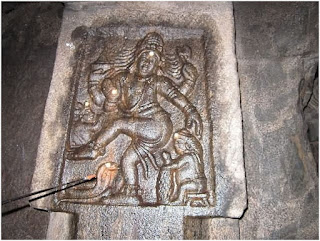 முதலாம் மகேந்திரவர்மன் பொ.யு ஏழாம் நூற்றாண்டில் ( 600-630 CE ) இங்கு உருவாக்கிய சிவனை “தூண்-ஆண்டார்” என்று தமிழிலும் ஸ்தம்பேஸ்வரர் என்று சமஸ்கிருதத்திலும் ( பல்லவ கிரந்த எழுத்துக்களில் ) அழைக்கப்பட்டுள்ளார்.
முதலாம் மகேந்திரவர்மன் பொ.யு ஏழாம் நூற்றாண்டில் ( 600-630 CE ) இங்கு உருவாக்கிய சிவனை “தூண்-ஆண்டார்” என்று தமிழிலும் ஸ்தம்பேஸ்வரர் என்று சமஸ்கிருதத்திலும் ( பல்லவ கிரந்த எழுத்துக்களில் ) அழைக்கப்பட்டுள்ளார்.8th century Gandheshwara Shiva temple ithyphallic Nataraja, Sirpur monuments Chhattisgarh

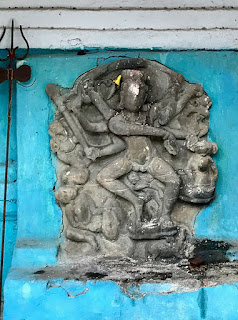
The site excavations after 1960, particularly after 2003, have yielded 22 Shiva temples, 5 Vishnu temples, 10 Buddha Viharas, 3 Jain Viharas, a 6th/7th century market and snana-kund (bath house). The site shows extensive syncretism, where Buddhist and Jain statues or motifs intermingle with Shiva, Vishnu and Devi temples.
The region was conquered and plundered by the armies of Delhi Sultanate and later Deccan Sultanates. The town and temples were damaged in the wars and were abandoned. Dense vegetation grew over it and floods deposited silt. There is also evidence of possible earthquake damage. 20th and 21st century excavations have unearthed many monuments. The site is large and artwork stick out of farmlands and dirt roads in and near Sirpur.ஆந்திர மாநிலத்தில் விஜயவாடாவிற்கு ஐந்து கிலோமிட்டர் தொலைவில் உள்ள ஒரு பாரம்பர்ய சின்னம் மொகலராஜபுரம் குடைவரைகள்.
Ravanaphadi Cave of Sixth Century by Chalukyas of Aihole :-
Although it was a common practice to depict Lord Shiva in dancing posture with ten arms, it is quite unusual to show Him along with the Saptamatrukas. Similarly depiction of Bhringi in Natesamurthy reliefs or Umamahesvara Panels was a common feature in latter day Medieval Sculptures of the same. But in South India he has been rarely shown, but here in this Sixth Century Rock Cut Cave of Chalukyas, we see so many related themes and Sculptures that are a feast to the Eye. In his two upper arms he holds aloft the Karkkodaga Snake in a playful gesture, being the most deadly of all the Ashtanagas. In his right side arms he holds the long handled Parasu ( Axe ) while another hand shows the gesture of protection as an abhinaya. A corresponding left side hand similarly shows blessing of Boons in a similar Abhinaya posture. A small Trishula is also held on the left side, while yet another arm rests on his left thigh. A normal right hand shows a Kadaga or Upadesa Mudra while the normal left hand is stretched out as a Gajahastha. The feet are placed forming a Chatura Thandava posture of the legs, planting the left sole firmly on the ground while the right foot is placed in Utkuditha posture with only the toes placed on the ground but the ankle is lifted up. The Ear ornaments show the usual Iconographic disparity. The Padra Kundla is all too prominently shown in the left ear. All the deities in the cave are shown with lengthy Crowns adorned in rich gems like array, while Shiva in addition sports the Crescent Moon on his right. His waist garment is worn tight held together in place with a snake dangling as his hip belt. Even his Yagnopavita hangs loose upto his ankle like a Jewellery. Another large snake swung over his left shouder like an Upavita is coiled on one right arm and hangs down below spreading his hood widely. The Snakeskin is shown clearly in its pattern like the Third Eye, His Jewellery, Kadaga, Noopura etc.
Once upon a time the whole cave was painted in natural pigments on the inside but you can see the remnants only now in all the panels. Skandha standing on his left is damaged while Gowri standing next shows her elegance in her admiring look she poses at Her Lord. A Two armed Ganesha stands on his right and next is Vaishnavi. Bhringi in dancing posture is shown next to Vaishnavai. The left side wall of this Mandapa section shows a Tricephalic Brahmi, Mahesvari and Kaumari all in a row while the opposite wall shows Varahi, Aindrani and Chamunda. Almost all the Matrukas shows some sort of Abhinaya or Nritta posture. Because of holding the Serpent above, Dancing Shiva in this Cave might be termed as of Bhujangalalitha Posture but the presence of all his parivara and the Chatura Thandava Posture can justify this being the Sandya Nritta also. Anyway I leave it to the discretion of my readers to judge this.


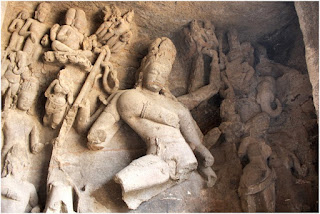



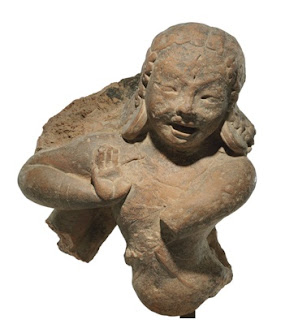

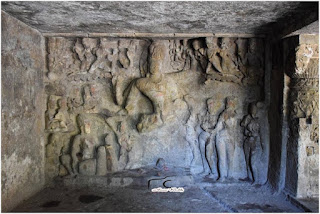





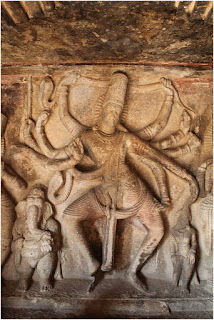
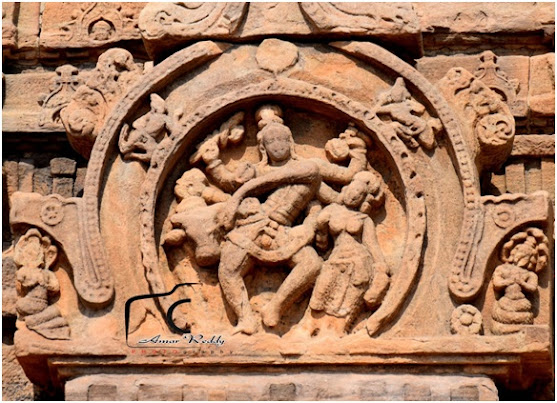





.jpg)







